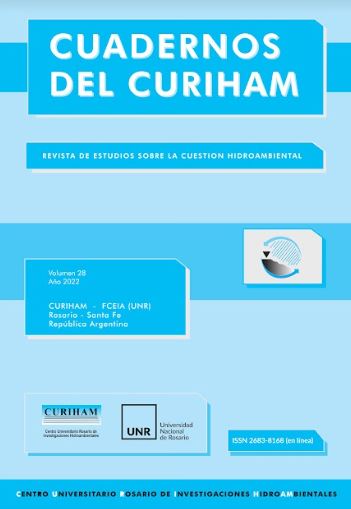Adaptation of the FAO´s method to assess real evapotranspiration in the SHALL hydrological simulation model
DOI:
https://doi.org/10.35305/curiham.v28i.185Keywords:
FAO method adaptation, evapotranspiration, flatland, SHALL modelAbstract
Considering the predominance of the vertical direction in the exchange flows between hydrological components of the plain systems and, consequently, the preponderance of evapotranspiration as a process, an adaptation of the methodology proposed by FAO to the variables used by the SHALL hydrological model is presented. This model is suitable for continuous simulation in plain areas. The model is quasi-3D hydrodynamic, which considers the underground and surface components of water flows, together with the vertical flows towards the aquifer and the atmosphere. The model has been applied in open systems in the south of Santa Fe province and closed systems in the La Pampa province and is currently being implemented in depressed areas of Buenos Aires province. For the adaptation, an estimate of extreme effective saturation is proposed according to the moisture retention curves adjusted with Brooks-Corey formula. Following the guidelines of the publication FAO No. 56, an estimate of the effective limit saturation is presented for which, below it, the vegetal covers begin to restrict the supply of potential evapotranspiration, and the coefficient of hydric stress based on the calculated limit saturations, to estimate, finally, the real evapotranspiration based on variables contemplated by the SHALL model components.
Downloads
References
Allen R., Pereira, L., Raes D., Smith, M. (2006). FAO. Evapotranspiración del cultivo Guías para la determinación de los requisitos de agua de los cultivos. FAO. Riego y Drenaje N° 56. ISSN 0254-5293. © FAO 2006.
Brooks, RH y Corey, AT (1964) Propiedades hidráulicas de los medios porosos y su relación con el diseño de drenaje. Transacciones de la ASAE, 7, 26-28. https://doi.org/10.13031/2013.40684
Caamaño Nelli, G. y Zimmermann, E. (1990). Tipología de los Sistemas Hidrológicos Superficiales. XVI Congreso Nacional Asociación Argentina Geofis. y Geod.. Bahía Blanca. argentino
Feddes, RA (1982). Simulacion de crecimiento de plantas y produccion de cultivos. Ed.: Penning de Vries, FWT, van Laar, HH Wageningen. ISBN 9789022008096 - pág. 194 - 209.
Fertonani, M., y Prendes, H. (1983) Hidrología en áreas de llanura. Aspectos Conceptuales Teóricos y Metodológicos. Coloquio de Hidrología de Grandes Llanuras. Olavarría. Argentina., 1, págs. 119-156.
Kovacs, G. (1983). Principios Generales de Hidrología de las Planicies. Coloquio de Hidrología de Grandes Llanuras. Olavarría. Argentina, págs. 297-357.
Kruse, E. y Zimmermann, E. (2002). Hidrogeología de grandes llanuras. Particularidades en la llanura pampeana (Argentina). En: Publicación del Taller Aguas Subterráneas y Desarrollo Humano (pp. 2025-2038).
Méndez Zacarías J. y Zimmermann E. (2011). Uso de Sistemas de Información Geográfica para Parametrización de Modelos de Simulación Hidrológica en Llanuras. XXIII Congreso Nacional del Agua y VI Simposio de Recursos Hídricos del Cono Sur. Resistencia. argentino
Tricart, J. (1983) L'Hydrologie des Grans Plains, Quelques Reflexions Methodologiques. Coloquio de Hidrología de las grandes Llanuras. Olavarría, Argentina, 2, págs. 1191-1193.
Zimmermann E. y Riccardi, G. (2000) Modelo de simulación hidrológica superficial para áreas de llanura. XIX Congreso Latinoamericano de Hidráulica. córdoba argentino
Zimmermann, E. y Riccardi, G. (2003). Modelo hidrológico superficial y subterráneo desarrollado para la simulación de sistemas de llanura. 1. Aplicación en el sistema Ludueña (Santa Fe, Argentina). Boletín Geológico y Minero, 114(2), 147-158.
Zimmermann E. y J. Meca (2010). Aplicación del modelo SHALL en los sistemas hidrológicos de las lagunas don Tomás y bajo Giuliani (La Pampa, Argentina) para la evaluación de impactos provocados por efluentes y escurrimientos. I Congreso Internacional de Hidrología de Llanuras. Azul, Buenos Aires, Argentina.
Published
How to Cite
Issue
Section
License

This work is licensed under a Creative Commons Attribution-NonCommercial-ShareAlike 4.0 International License.



























